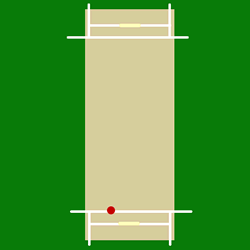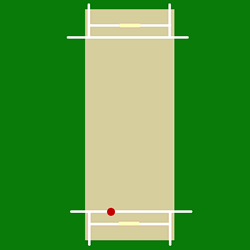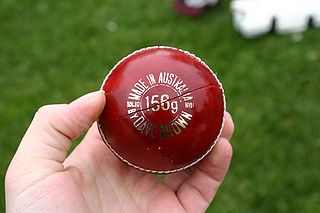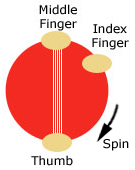In cricket, a bowling machine is a device which enables a batsman to practise (usually in the nets) and to hone specific skills through repetition of the ball being bowled at a certain length, line and speed. It can also be used when there is no-one available to bowl, or no one of the desired style or standard.
There are a number of different types of bowling machine available to cricket coaches, each quite different in the ways they achieve the required delivery, though most allow the use of remote control, so that a coach can be closer to a batsman when the stroke is played.
Ball-throwing machines for cricket have been used for over a century and originally followed a more slingshot design, [1] which later gave way to motorised wheels and programmable machines.
This type of machine is by far the most common. It is simple, strong and reliable, as well as being able to bowl a useful range of deliveries.
The main mechanism of the machine consists of two heavy wheels, between 30 and 50 cm in diameter, fitted with solid or pneumatic rubber tyres, each driven by its own electric motor. These are mounted in a frame such that the wheels are in the same plane, about 7 cm apart (slightly less than the diameter of a cricket ball). A ball joint allows the machine a wide range of movement. The whole assembly is mounted on a sturdy tripod or other frame so that the plane of the wheels is roughly at the height that a typical bowler would release the ball. A chute delivers the ball between the wheels, protecting the coach's hands.
The motors are typically powered by a car battery, and turn in opposite directions. A controller allows variation of the speed of each wheel, allowing the machine to be slowed down for less experienced batsmen, or when the motors are not running at the same speed, swing or spin bowling can be simulated.
These machines will work with any ball of roughly the right size and weight, such as normal cricket balls or tennis balls. However, they usually work best with their own balls, bowling machine balls which are made of hard plastic, and are covered in dimples. These dimples are to help the spinning wheels grip the ball and, for example, improve the swing or spin of deliveries when those types of deliveries are desired.
This is achieved by setting both wheels to the same speed, as fast as the batsman is able to deal with, although the machine itself would have to be tipped horizontally. The coach can move the machine around slightly to vary the line and length of each ball.
The plane of the wheels is flat, and the motors are set to run at slightly different speeds. This means the ball will spin about an axis perpendicular to the ground, causing it to swing due to the Magnus effect. If the ball is spinning anticlockwise (looking from above) the ball will swing from right to left; clockwise spin results in a swing from left to right. This means that if the coach slows down the wheel on one side, ball will swing in that direction. The swing produced in this way is different from normal swing bowling, however – it is much more like a curling ball in football.
To achieve spin, old style bowling machines should be tilted to one side, and the wheels set to different speeds as per swing bowling. It will also probably be necessary to make the machine bowl significantly more slowly. The combined action of the spin imparted by the wheels, and the non-perpendicular axis of that spin will cause the ball to bounce up at an angle.
This is difficult to achieve since the operator cannot control exactly how the ball will roll into the machine and between the wheels. However, by the law of averages, a ball will occasionally come out with its seam at the correct angle, and bounce unpredictably as a result.
To get balls that bounce unnaturally high or low, the plane of the machine must be set so that it is vertical. Not all machines can do this, simply because their ball joint doesn't give the required range of movement. To get balls that bounce higher than normal, the lower wheel should spin slightly faster than the upper. Deliveries that bounce much lower than normal are less common and are usually the result of the ball striking a broken-up patch of ground. These balls can still be simulated, however, by increasing the speed of the upper wheel.
This design is significantly less common than the mechanical type and operates using a completely different principle.
Most of the space in the machine is a hopper that contains the balls. At the bottom of the hopper, near the front, is a rotor with space for six balls. The balls slot into the spaces on the rotor by gravity, which then takes them into the innards of the mechanism. The rotor passes over a trap-door, which the ball opens with its weight, falling into a small chamber.
A pump is used to provide a flow of air into the chamber that the ball drops into. The airflow pushes the ball along the chamber to rubber ring, or gasket, known as a "restrictor". The restrictor has a hole through it that is sightly smaller than the ball, which the ball presses up against. This seals the hole, so air pressure builds up in the chamber. When the pressure is so great that the restrictor can no longer hold it, the ball bursts through, out of the main body of the machine and into an external tube, which guides it upwards and releases it at the height of a bowler's arm.
A system exists that allows air to escape from the barrel shortly after it has passed the restrictor. This reduces the pressure on the ball, reducing its muzzle velocity. Closing this increases the speed to its maximum; its maximum speed is 160+ km/h (100+ mph).
To do this a curved piece of tubing is attached to the end of the barrel. The ball rolls around this causing it to spin and swing.
The tubing used for swing bowling can also be used for spin bowling, by pointing the curve somewhere between vertical and horizontal.
Seam bowling is impossible on this machine as it only accepts tennis balls and cricket training balls such as Slazenger's "Slazball" (a hard, small, low-bounce, heavy ball, similar in appearance to a tennis ball but usually red in colour). Neither of these types of ball has a seam.
The tubing can again be used, this time to simulate high and low bounce by mounting the tube vertically.
Both of the types of machines described above are fairly simple designs, intended for regular, hard use by clubs, and hence are simple to operate and reliable. They can only simulate one type of delivery with the machine in a given configuration and have other limitations, particularly with spin bowling, which limit their usefulness to players at the highest levels of the game.
Programmable bowling machines are intended to overcome some of these limitations by rapidly re-configuring themselves to bowl different types of delivery in quick succession.
A programmable bowling machine called "Merlyn", which its makers claimed could "bowl any ball known to man" [2] received much public attention when it was used by the English cricket team in the run-up to and during the 2005 Ashes series.
Originally a one-off, Merlyn was built by Henry Pryor, a cricket coach in Herefordshire. Its mechanism has not been publicly revealed, though it is safe to assume it is much more complex than the other machines. Unlike the old two-wheeled bowling machines, the "Merlyn" bowling machine, can deliver spin without the head of the machine being tilted. [3]
Crucially, the machine was claimed to be able to emulate Shane Warne's leg breaks, and although he is dismissive of its usefulness, [4] the England batsmen disagree, and consider their ability to play spin bowling significantly improved. [5] [6]
The machine, as well as its mechanical abilities, also has significant elements of computer-control built in. It is claimed that it can reproduce an over from a particular bowler if fed the correct data.
One of the more unnerving aspects of the machine is that it provides no indication of the type of ball it is about to bowl until the ball has left the machine. This forces batsmen to work on their instinctive batting, rather than trying to second guess the bowler.
There has been some other advances in technology in the 20 years since Merlyn appeared, including three-wheeled machine and video projection of a bowler onto the machine, such as used earlier with baseball machines. Loughborough University demonstrated visual feedback by showing a representation of the bowler projected onto a screen in 2006. The ball would be released as the virtual bowler's hand reaches the hole from which the ball is released. It is not clear whether they were able to go into production or commercialise their technology. [7]
In the winter of 2009/10 the ECB acquired 20 of the "Merlyn" machines, one for each county and two for the performance centre at Loughborough. The machines were produced were produced as joint project between Merlyn and a company called Bola. [8]

Leg spin is a type of spin bowling in cricket. A leg spinner bowls right-arm with a wrist spin action. The leg spinner's normal delivery causes the ball to spin from right to left when the ball bounces on the pitch. For a right-handed batter, that is away from the leg side, and this is where it gets the name leg break.

Off spin is a type of finger spin bowling in cricket. A bowler who uses this technique is called an off spinner. Off spinners are right-handed spin bowlers who use their fingers to spin the ball. Their normal delivery is an off break, which spins from left to right when the ball bounces on the pitch. For a right-handed batsman, this is from his off side to the leg side. The ball breaks away from the off side, hence the name 'off break'.

Bowling, in cricket, is the action of propelling the ball toward the wicket defended by a batter. A player skilled at bowling is called a bowler; a bowler who is also a competent batter is known as an all-rounder. Bowling the ball is distinguished from throwing the ball by a strictly specified biomechanical definition, which restricts the angle of extension of the elbow. A single act of bowling the ball towards the batsman is called a ball or a delivery. Bowlers bowl deliveries in sets of six, called an over. Once a bowler has bowled an over, a teammate will bowl an over from the other end of the pitch. The Laws of Cricket govern how a ball must be bowled. If a ball is bowled illegally, an umpire will rule it a no-ball. If a ball is bowled too wide of the striker for the batsman to be able to play at it with a proper cricket shot, the bowler's end umpire will rule it a wide.
In the game of cricket, the cricket pitch consists of the central strip of the cricket field between the wickets. It is 22 yd (20.12 m) long and 10 ft (3.05 m) wide. The surface is flat and is normally covered with extremely short grass, but can be completely dry or dusty soil with barely any grass or, in some circumstances, made from an artificial material. Over the course of a cricket match, the pitch is not repaired or altered other than in special circumstances - meaning that it will change condition. Any grass on the pitch in the game's first over, for example, may have disappeared by twentieth over due to wear.

This is a general glossary of the terminology used in the sport of cricket. Where words in a sentence are also defined elsewhere in this article, they appear in italics. Certain aspects of cricket terminology are explained in more detail in cricket statistics and the naming of fielding positions is explained at fielding (cricket).

In cricket, a no-ball is a type of illegal delivery to a batter. It is also a type of extra, being the run awarded to the batting team as a consequence of the illegal delivery. For most cricket games, especially amateur, the definition of all forms of no-ball is from the MCC Laws of Cricket.

A cricket ball is a hard, solid ball used to play cricket. A cricket ball consists of a cork core wound with string then a leather cover stitched on, and manufacture is regulated by cricket law at first-class level. The trajectory of a cricket ball when bowled, through movement in the air, and off the ground, is influenced by the action of the bowler and the condition of the ball and the pitch, while working on the cricket ball to obtain optimal condition is a key role of the fielding side. The principal method through which the batter scores runs is by hitting the ball, with the bat, into a position where it would be safe to take a run, or by directing the ball through or over the boundary. Cricket balls are harder and heavier than baseballs.
In cricket, a yorker is a ball bowled which hits the cricket pitch around the batsman's feet. When a batsman assumes a normal stance, this generally means that the cricket ball bounces on the cricket pitch on or near the batsman's popping crease. A batsman who advances down the pitch to strike the ball may by so advancing cause the ball to pitch at or around his feet and may thus cause himself to be "yorked". Yorkers are considered to be one of the most difficult deliveries to bowl.
Fast bowling is one of two main approaches to bowling in the sport of cricket, the other being spin bowling. Practitioners of pace bowling are usually known as fast bowlers, quicks, or pacers. They can also be referred to as a seam bowler, a swing bowler or a fast bowler who can swing it to reflect the predominant characteristic of their deliveries. Strictly speaking, a pure swing bowler does not need to have a high degree of pace, though dedicated medium-pace swing bowlers are rarely seen at Test level in modern times. There are different categories in fast bowling known in international cricket such as fast bowling, medium fast bowling, medium bowling, etc.
Swing bowling is a technique used for bowling in the sport of cricket. Practitioners are known as swing bowlers. Swing bowling is generally classed as a subtype of fast bowling.

Spin bowling is a bowling technique in cricket, in which the ball is delivered relatively slowly but with the potential to deviate sharply after bouncing. The bowler is referred to as a spinner.

A leg cutter is a type of delivery in the sport of cricket. It is bowled by fast bowlers.
In the sport of cricket there are two broad categories of bowlers: pace and spin. Pace bowlers rely mostly on the speed of the ball to dismiss batsmen, whereas spin bowlers rely on the rotation and turn off the ball to deceive the batter.
Baseball and cricket are the best-known members of a family of related bat-and-ball games. Both have fields that are 400 feet (120 m) or more in diameter between their furthest endpoints, offensive players who can hit a thrown/"bowled" ball out of the field and run between safe areas to score runs (points) at the risk of being gotten out, and have a major game format lasting about 3 hours.

In cricket, a scorer is someone appointed to record all runs scored, all wickets taken and, where appropriate, the number of overs bowled. In professional games, in compliance with Law 3 of the Laws of Cricket, two scorers are appointed, most often one provided by each team.

A delivery or ball in cricket is a single action of bowling a cricket ball toward the batter. Once the ball has been delivered, batters may attempt to score runs, with the bowler and other fielders attempting to stop this by getting the batters out. When the ball becomes dead, the next delivery can begin.
Wrist spin is a type of bowling in the sport of cricket. It refers to the cricket technique and specific hand movements associated with imparting a particular direction of spin to the cricket ball. The other spinning technique, usually used to spin the ball in the opposite direction, is finger spin. Wrist spin is bowled by releasing the ball from the back of the hand, so that it passes over the little finger. Done by a right-handed bowler, this imparts an anticlockwise rotation to the ball, as seen from the bowler's perspective; a left-handed wrist spinner rotates the ball clockwise.
Finger spin is a type of bowling in the sport of cricket. It refers to the cricket technique and specific hand movements associated with imparting a particular direction of spin to the cricket ball. The other spinning technique, generally used to spin the ball in the opposite direction, is wrist spin. Although there are exceptions, finger spinners generally turn the ball less than wrist spinners. However, because the technique is simpler and easier to master, finger spinners tend to be more accurate.
In the sport of cricket, the bowling action is the set of movements that result in the bowler releasing the ball in the direction of the batsman.

In ball sports, topspin or overspin is a property of a ball that rotates forwards as it is moving. Topspin on a ball propelled through the air imparts a downward force that causes the ball to drop, due to its interaction with the air. Topspin is the opposite of backspin.